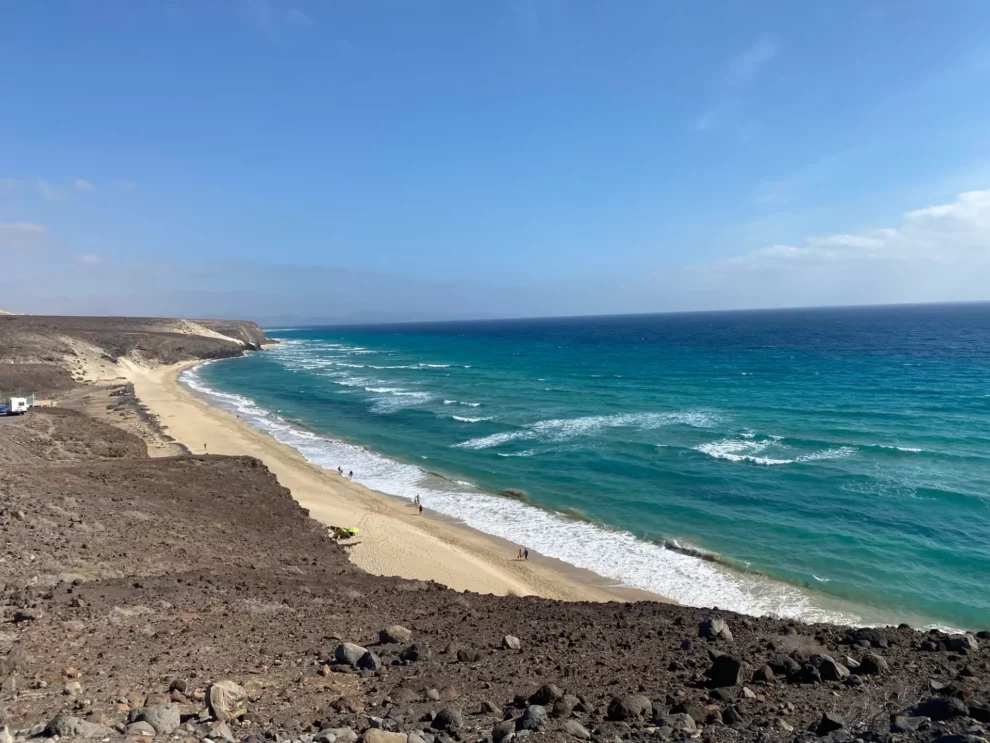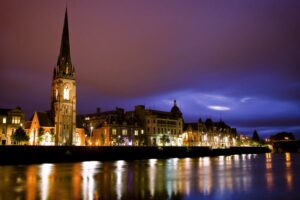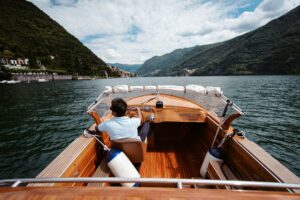As Pat Shortt says about Ireland: “She’s a great little country, if only you could put a roof on her.” There is a reason the Romans called it Hibernia (Winterland). The darker months of the year here are some hard yards — it can be a great time to take a beakerful of the warm south.
Fuerteventura is an ideal island for sunseekers all year-round but especially to sun-starved Northern Europeans in winter.
The Canary Islands are geographically African; Fuerteventura, the most easterly, is just 100 kms from the Moroccan coast. Unlike some of its sister islands in The Canaries, Fuerteventura has a warm, dry, even arid climate. If there is cloud cover, it is usually dissipated by noon — and rain is rare and short-lived. Outdoor life is natural and agreeable all year round.
Lying as they do, in a strategic position between Africa, Europe, and the Americas, these islands were invaded by the Castilians in the 15th century. The natives who occupied Fuerteventura before the Castilian invasion were wiped out despite stoic resistance over the next almost 100 years. There were attempts over the centuries by other colonisers, to take the islands but they remain Spanish to this day, politically, culturally, and astronomically.
This latter is a terrific bonus as Spanish fare is widely appealing and especially suited to an island with an abundance of seafood. A few restaurants really stand out but it’s hard to find poor food in Fuerteventura.
With its primary business being tourism these days, the island caters to many nationalities. You will get a warmer reception if you enquire “Habla Ingles?” before launching into English in shops and restaurants but most local people speak enough English to interact with visitors. For these reasons, Fuerteventura is an easy, relaxing holiday for people who want dependable warm weather, reliably good food, and ease in navigating the relatively unfamiliar.
It’s an excellent choice for a family holiday. The island is mostly desert and somewhat barren between conurbations — the prettiness comes less from flora, which are scare, more from charming villages, the mountains, the coastline, and the sea. This is a small island (you could drive the length of it in a day) but it has an abundance of swimming coves and sandy beaches.

The best beach for a day with a bucket and spade is in El Cotillo where there’s a natural lagoon. Except for very windy days, (when a red flag is raised) this lagoon offers wonderful calm, sea swimming even when the sea around it is rough. Snorkelling is a lot of fun here as the fish are used to sharing the lagoon with humans and can be observed up close in their natural habitat. Note that some humans can also be observed in their natural state on the beach at El Cotillo, as nudism is common (although by no means universal) for men and women.
El Cotillo is also the location of some excellent restaurants — one that stands out is La Vaca Azul (vacaazul.es). It’s worth booking because it can be hard to get a table at this popular spot. Ask for a table with a view over the bay. If one wanted a completely relaxing holiday without a great deal of variation, choosing El Cotillo as a base and staying there would be an excellent option.
A much longer and more dramatic beach is to be found at Sotavento. Swimming, running, and lounging on the sand are all enjoyed here, although sea swimmers should note, the waves are more dramatic than in the lagoon at El Cotillo. However, those strong winds are ideal for kite surfing and windsurfing. When the sporty surf folk take to the sea and the air, it’s a sight to see — but this is such a spacious beach, it rarely gets crowded.
Another pleasant island activity that can be adapted to all levels of fitness and ability, is hiking in the hills. The recommendation of the locals for the best views is to rise before dawn, use torches to set off and catch the sun rise as you climb. This also avoids the hottest part of the day. The views from the peaks are exceptional and the feeling of virtue that comes from being an early riser mixed with fresh air and exercise is a heady and healthy mix.

Pico de la Zarza is the highest hill in Fuerteventura and has an easy trail. It’s such a gentle gradient, it barely counts as hiking. Certainly, you can do it in running shoes but it is long-ish so check how far your party is willing and able to walk before you set off. At the top are beautiful views on both sides of the island.
Occasionally the winds will be so high that swimming isn’t possible and the sand is whipped about on the beach, making it hard to sunbathe.
These are days to enjoy exploring the island. Corralejo is an unabashedly tourist town, with modern facilities catering to tourists. Here’s the place to do your shopping, have a coffee or a cocktail, and also enjoy the open-air market that happens a few days a week.
However, you’re never far from a beach on Fuerteventura and the dunes in Corralejo with the views of Lobos Island and Lanzarote Island make it worth a visit, too. If you’re missing home, Murphy’s Bar in Corralejo run by Louth woman Linda Carroll will give you a warm welcome, a pint of Guinness and sometimes, traditional Irish music.
In contrast to Corralejo is Betancuria, named for the first European invader Jean de Béthencourt. With the mindset of a military man who knew he’d have to defend his position, Béthencourt chose an inland spot among the mountains to make his base. This means this town (village? It numbers less than a thousand inhabitants today) has remained safe, from the enemies Béthencourt anticipated and from the blight of rapid, modern development to accommodate tourists. It’s an exceptionally pretty and well-preserved village. The church there is worth a visit to anyone with a passing interest in architecture.

On the road to Betancuria is the Mirador Guise y Ayose, with its famous statues. Mirador is a versatile word but in this context means ‘outlook’ and it is another great spot for breathtaking views of nature. The statues pay tribute to the male leaders of the original indigenous people: Ayoze, King of Jandía, and Guise, King of Maxorata. The stories of their courage and abilities are half-mythical by now and the twice as large as life statues invoke their majesty effectively.
If you want to know more about the indigenous people who were here before Europeans, visit the Museo Arqueologico y Etnografico (Archaeological and Ethnographic Museum).
Other fun ideas are the little Museum of Cheese and the (separate) Museum of Salt where you can learn about how salt is traditionally extracted from the sea. Considering salt is such a plentiful and ubiquitous condiment, it’s extraordinary that this process is new and fascinating information to most. All the museums on the island are free.
Source: Irish Examiner









